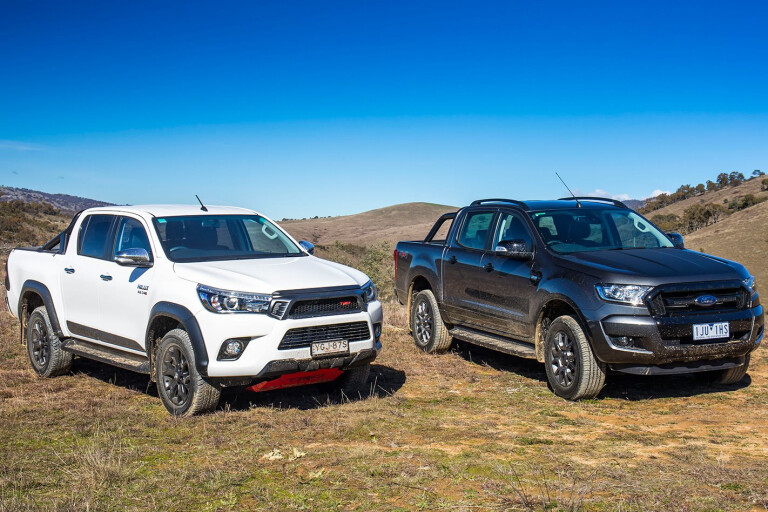
Make no mistake, this is war.
Toyota’s Hilux and Ford’s Ranger are fighting it out to not only be Australia’s most popular ute and 4x4, but – crucially – Australia’s most popular vehicle overall, ahead of the likes of Toyota’s Corolla and the Mazda3.
Year-to-date sales of the Hilux are 17,917, with the Ranger close behind at 16,587. Both are ahead of the Corolla 15,624 and Mazda3 14,562.
More tellingly, Ranger sales are climbing faster than Hilux, and the Ranger is already ahead in 4x4 sales, which is where most of the sales are in the ute market. If current trends continue, the Ranger will wrest the mantle of Australia’s best-selling vehicle from the Hilux before year’s end.
 Within the extensive Hilux and Ranger model line-ups, which range from base work vehicles to well-appointed family transport, the higher-spec 4x4 dual-cabs are hot property on the showroom floor. It’s no surprise then that Toyota and Ford have pitched both of these models in that direction.
Within the extensive Hilux and Ranger model line-ups, which range from base work vehicles to well-appointed family transport, the higher-spec 4x4 dual-cabs are hot property on the showroom floor. It’s no surprise then that Toyota and Ford have pitched both of these models in that direction.
For Toyota, the TRD model sits above the top-spec SR5, whereas over at Ford the FX4 slots between the popular XLT and the top-spec Wildtrak. So, how do they compare and which one is worthy of your hard-earned dollars?
Toyota Hilux TRD
It has been almost ten years since the TRD nameplate was attached to a Hilux. That was the previous generation Hilux – and a petrol
V6 at that. TRD stands for Toyota Racing Development, a division within Toyota that deals with racing and performance parts.
The previous (launched in 2008) Hilux TRD was a product of Toyota Australia’s TRD division and came with a supercharger for the 4.0-litre petrol V6, Bilstein sports suspension, bigger front brake callipers and rotors, a body kit, and numerous styling details.
 Thanks to the supercharger, the power was up by nearly 30 per cent – to 225kW – and torque up 20 per cent to 453Nm. Nice on paper, but unfortunately it didn’t fully deliver on its promise and was withdrawn from sale after 18 months. Now it’s probably a collector’s item!
Thanks to the supercharger, the power was up by nearly 30 per cent – to 225kW – and torque up 20 per cent to 453Nm. Nice on paper, but unfortunately it didn’t fully deliver on its promise and was withdrawn from sale after 18 months. Now it’s probably a collector’s item!
Fast forward to 2017 and this latest TRD is diesel-only and has nothing that you’d traditionally associate with TRD, as there are no performance enhancements.
However, you get extra kit in the form of a prominent red skid plate, bespoke 18-inch rims, leather, a towbar, ute liner, soft tonneau and details such as new wheelarch flares, grille, lower bumper and tail-light covers. It comes in either black or white.
Powertrain and performance
The Hilux is powered by the now familiar 2.8-litre diesel that’s common to the Fortuner – it’s effectively what’s under the bonnet of the Prado, although the Prado’s 2.8-litre has counter-rotating balance shafts for even smoother running.
Despite a reduction in capacity over the previous 3.0-litre Hilux diesel, the 2.8 makes considerably more maximum torque (now 450Nm) and around the same power. So while the engine is more responsive in general give-and-take driving, it’s certainly no powerhouse pedal-to-metal and a fair way short of the performance of the Ranger.
It’s a pity the TRD badge didn’t come with a performance chip, a bigger exhaust and a bit more grunt.
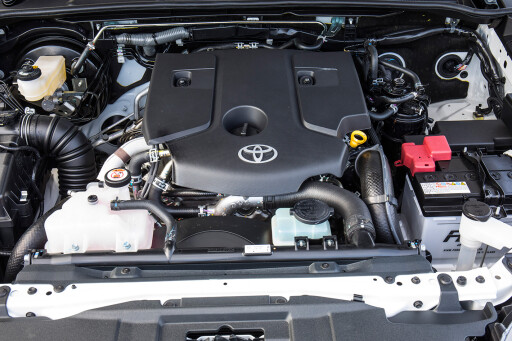 The six-speed automatic which replaced the five-speeder behind the 3.0-litre doesn’t help either in terms of performance, it just adds a second overdrive ratio rather than tightening up the ratio spread.
The six-speed automatic which replaced the five-speeder behind the 3.0-litre doesn’t help either in terms of performance, it just adds a second overdrive ratio rather than tightening up the ratio spread.
What’s worse is that the engine doesn’t carry the extra tall sixth all that well at legal highway speeds on undulating roads, so there’s a bit of shuffling back and forth between fifth and sixth. At least shift quality is good.
Still, for all that, the 2.8 is an agreeable engine. Smooth, quiet and torquey down low, but also happy to rev hard when asked. Compared to the relatively gruff Ranger it’s noticeably quieter, more refined and a bit more economical, but it does lack the Ranger’s grunt and ultimate performance.
On-road ride and handling
The Hilux feels quite nimble for a modern-day ute, due in part to the fact it’s now one of the smaller utes in most dimensions – it certainly feels smaller than the Ranger.
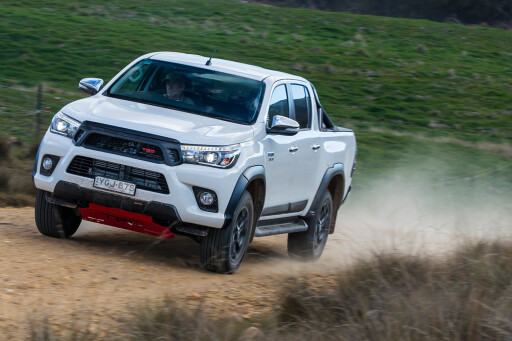 Toyota has also done well with steering feel, general handing response and road-noise abatement, apparently learning something from the refined and sweet-handling VW Amarok that appeared early in the development of this generation Hilux and was subsequently accessed by the Hilux’s engineering team.
Toyota has also done well with steering feel, general handing response and road-noise abatement, apparently learning something from the refined and sweet-handling VW Amarok that appeared early in the development of this generation Hilux and was subsequently accessed by the Hilux’s engineering team.
Either way, its general road manners are much improved on the previous Hilux, even if the ride is a bit sharp at the back when unladen – which is hard to avoid with a ute.
Off-road
The TRD’s trump card off-road is the notably long rear-wheel travel. At more than half a metre, it’s an improvement of near 70mm over the previous Hilux and is a best-in-class figure.
That wheel travel is backed by an extremely effective off-road-specific traction control system (A-TRC, in Toyota-speak) to provide 4x4 ability that’s as good as it gets in this class. Compared to the Ranger, and many others, the Hilux’s more compact dimensions can also be a bonus in tighter situations.
 Interestingly, the TRD, like the SR and SR5, has a driver-switched rear locker, but as its activation cancels the traction control on both axles, leaving the front diff effectively ‘open’, it’s more often than not a disadvantage.
Interestingly, the TRD, like the SR and SR5, has a driver-switched rear locker, but as its activation cancels the traction control on both axles, leaving the front diff effectively ‘open’, it’s more often than not a disadvantage.
In contrast, the Ranger’s locker leaves the front-axle traction control active, which is a bonus. This would most likely put the Ranger in front of the Hilux for general tractive ability, if it weren’t for the Hilux’s extra rear travel.
It’s worth noting the TRD’s red bash plate is an addition to the standard bash plate, which remains in-situ, and while it may afford extra protection it can also reduce the approach angle in some situations.
Cabin, accommodation and safety
The TRD has smart-key entry and push-button start, as well as the tilt-and-reach steering wheel that’s standard across the Hilux range. All of this kit sets it aside from any Ranger – FX4 included – as well as most other utes.
Like all Hilux models, the TRD is nicely finished inside and has a passenger-car-style dash dominated by the large love-it-or-leave it tablet-style touchscreen, while the TRD’s leather and electric adjust for the driver’s seat adds a touch of luxury. Five-star safety is thanks, in part, to seven airbags.
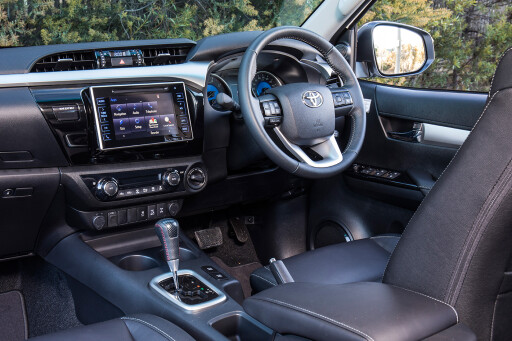 The Hilux’s cabin is one of the smaller in this class. Not that this affects the driver and front-seat passenger, but three big blokes would certainly prefer to be in the Ranger’s rear seat (or most other utes) rather than the Hilux.
The Hilux’s cabin is one of the smaller in this class. Not that this affects the driver and front-seat passenger, but three big blokes would certainly prefer to be in the Ranger’s rear seat (or most other utes) rather than the Hilux.
Practicalities
As with all 2.8-litre diesel automatic Hilux models, the TRD can legally tow up to 3200kg. If you wish to tow 3500kg like the Ranger, you’ll need the 2.8-litre diesel manual.
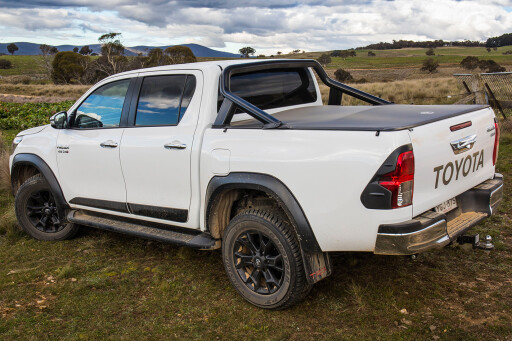 In our tow test, we put 2800kg behind the Hilux and it did it without fuss. Likewise, it carried its maximum payloads without a problem – even if they are shy of the Ranger’s maximum payloads by 100kg or so at this TRD versus FX4 spec level. This aside, the Hilux is the practicality king in terms of dealer support and both factory and aftermarket accessories.
In our tow test, we put 2800kg behind the Hilux and it did it without fuss. Likewise, it carried its maximum payloads without a problem – even if they are shy of the Ranger’s maximum payloads by 100kg or so at this TRD versus FX4 spec level. This aside, the Hilux is the practicality king in terms of dealer support and both factory and aftermarket accessories.
Toyota Hilux TRD specs:
Engine: 2.8-litre 4-cyl turbo-diesel
Max power: 130kW @ 3400rpm
Max torque: 450Nm @ 1600-2400rpm
GVM: 3050kg
Towing capacity: 3200kg
Fuel tank capacity: 80 litres
Ford Ranger FX4
There are those among us who, upon hearing of the Ranger FX4, immediately think of the F150 FX4, America’s favourite pick-up truck made more off-road ready with extra underbody protection, upgraded dampers and a rear locker.
However, it was quickly a case of ‘don’t get too excited’, as FX4 in Ranger terms means cosmetics and kit, not mechanical changes – aside from a new wheel and tyre package.
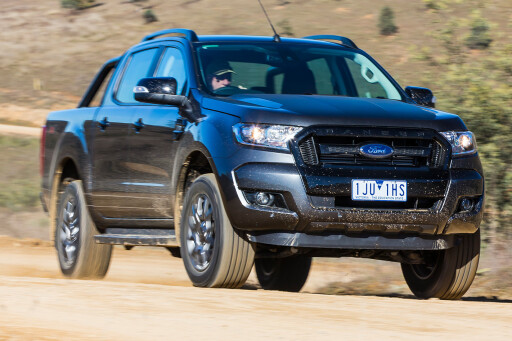 The FX4 is essentially a ‘black’ or ‘dark’ special-edition version of the volume-selling XLT – an alternative ‘look’ for the XLT, if you like. Key exterior features include bespoke dark grey 18s (instead of the XLT’s 17s), black bonnet and tailgate panel decals, and black grille, roof rails, mudguard flares, mirror bodies, sportsbar, rear bumper, side-steps, door handles and fog-light surrounds.
The FX4 is essentially a ‘black’ or ‘dark’ special-edition version of the volume-selling XLT – an alternative ‘look’ for the XLT, if you like. Key exterior features include bespoke dark grey 18s (instead of the XLT’s 17s), black bonnet and tailgate panel decals, and black grille, roof rails, mudguard flares, mirror bodies, sportsbar, rear bumper, side-steps, door handles and fog-light surrounds.
Inside, there are FX4-branded leather seats and various black highlights.
Powertrain and performance
The FX4 is powered by the 3.2-litre five-cylinder diesel, effectively the default engine across the Ranger model line-up; although, there’s a very underrated 2.2-litre four-cylinder diesel in lower-spec 4x4 models. To some people, a five-cylinder engine sounds wrong – perhaps out of balance – as it doesn’t have an even number of cylinders.
To put the record straight, an in-line five is inherently smoother than an in-line four, and the Ranger’s engine is smooth, except for a somewhat lumpy idle (a typical in-line-five trait).
Comparison review: Five premium mid-size SUVs
However, the five-cylinder design brings a likeable character and offbeat sound, but what’s even better about this engine is the strong power delivery right from idle. By just 1500rpm it’s already producing its maximum torque figure of 470Nm, and it responds accordingly. What’s more, the engine holds that 470Nm for the next 1250rpm, which provides perfectly linear power delivery in this vital rev range.
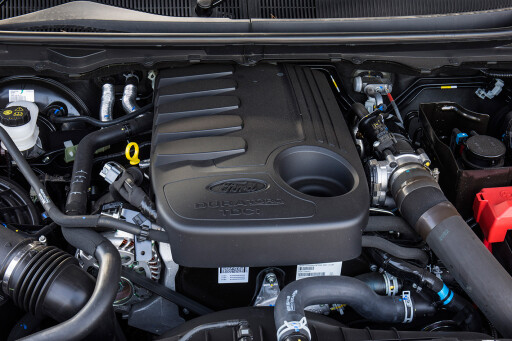 Much of the Ranger’s strong power delivery comes courtesy of the big 3.2-litre engine, the biggest in the class along with the similar-engined Mazda BT-50. It’s nearly half a litre bigger (443cc, to be exact) than the Hilux and feels like it, too.
Much of the Ranger’s strong power delivery comes courtesy of the big 3.2-litre engine, the biggest in the class along with the similar-engined Mazda BT-50. It’s nearly half a litre bigger (443cc, to be exact) than the Hilux and feels like it, too.
It’s also a bit gruff and noisy compared to the Hilux, and it’s not as polished around the edges. So where the Ranger’s engine feels blokey, relaxed and muscular, the Hilux’s is quieter and more refined, despite working generally harder.
The Ranger is geared more appropriately for most open road conditions and makes better use of its six ratios than the overly tall-geared Hilux. Good shift quality and smart shift protocols characterise the Ranger’s ZF automatic, although it is not noticeably better in this regard than the Hilux’s six-speeder.
On-road ride and handling
Climb into the FX4 after the TRD and it feels big, but it also feels instantly light and manoeuvrable as soon as you turn the steering wheel, thanks to its electric power steering.
 The FX4’s steering is actually feather-light at parking speeds, belying the Ranger’s size and bulk. The steering then firms up nicely as speeds increase to give plenty of feedback out on the highway, where the Ranger has a reassuring and settled feel, no doubt helped by the extra long (3220mm) wheelbase. When unladen, the FX4, like all Ranger 4x4 dual-cabs, also rides surprisingly well.
The FX4’s steering is actually feather-light at parking speeds, belying the Ranger’s size and bulk. The steering then firms up nicely as speeds increase to give plenty of feedback out on the highway, where the Ranger has a reassuring and settled feel, no doubt helped by the extra long (3220mm) wheelbase. When unladen, the FX4, like all Ranger 4x4 dual-cabs, also rides surprisingly well.
Off-road
The FX4 has many things going for it off-road, and it all starts with generous suspension travel at both ends of the chassis. The Ranger’s supple, long-travel suspension allows it to ease over rough ground that many other utes – Holden Colorado, Isuzu D-MAX, Mitsubishi Triton and Nissan Navara – struggle on.
In this class, it’s comfortably better than most, even if it can’t match the standard-setting rear wheel travel of the Hilux.
 If the FX4 – or indeed, any Ranger 4x4 dual-cab – needs a leg up, there’s the driver-switched rear diff lock that, unlike others, leaves the traction control active on the front axle. The end result is 4x4 capability that’s as good as it gets in any of the popular utes, with only the Hilux and VW Amarok in the same league.
If the FX4 – or indeed, any Ranger 4x4 dual-cab – needs a leg up, there’s the driver-switched rear diff lock that, unlike others, leaves the traction control active on the front axle. The end result is 4x4 capability that’s as good as it gets in any of the popular utes, with only the Hilux and VW Amarok in the same league.
Only a few things count against the FX4 off-road: you notice its size in tight spots (even if the EPS helps with wheel twirling), the driver’s vision could be better, and the factory towbar does nothing for the departure angle.
Cabin, accommodation and safety
As flash-looking as the FX4 is when you’re walking up to it, there’s still not the convenience of keyless entry and push-button start. Nor are there other luxuries such as reach adjustment for the steering wheel, or even electric adjustment for the driver’s seat once you get inside.
 However, what you get is a big cabin with plenty of room for tall drivers. The FX4’s cabin, like all Ranger dual-cabs (as well as BT-50 dual-cabs), is also the longest in the class, so if you want to sit a tall passenger behind a tall driver, this is the place to do it. This cabin is wide across the back seat, a dimension only bettered by the Amarok in this class. Like the TRD, the FX4 has five-star ANCAP safety, but one less airbag.
However, what you get is a big cabin with plenty of room for tall drivers. The FX4’s cabin, like all Ranger dual-cabs (as well as BT-50 dual-cabs), is also the longest in the class, so if you want to sit a tall passenger behind a tall driver, this is the place to do it. This cabin is wide across the back seat, a dimension only bettered by the Amarok in this class. Like the TRD, the FX4 has five-star ANCAP safety, but one less airbag.
Practicalities
If you wish to tow or carry heavy loads, the Ranger FX4 will do the job as good as any of the popular mainstream utes, including the Toyota Hilux.
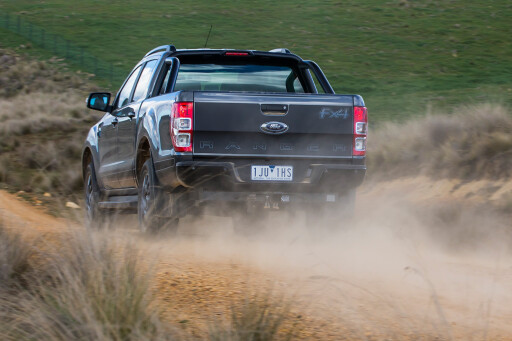 In our recent maxxed-out load and tow test, we put a 3500kg trailer weight behind the Ranger and it towed it without fuss. Likewise, we put 800kg in the tray (for 1000kg total payload) and it hardly noticed the weight.
In our recent maxxed-out load and tow test, we put a 3500kg trailer weight behind the Ranger and it towed it without fuss. Likewise, we put 800kg in the tray (for 1000kg total payload) and it hardly noticed the weight.
The FX4 (like all Rangers) has a class-leading 6000kg GCM and is well-supported by aftermarket and factory accessories.
Ford Ranger FX4 specs:
Engine: 3.2-litre 5-cyl turbo-diesel
Max power: 147kW @ 3000rpm
Max torque: 470Nm @ 1500-2750rpm
GVM: 3200kg
Fuel tank capacity: 80 litres
THE VERDICT
On the dollar count, the FX4 and TRD are almost identical. At the manufacturer’s list price the FX4 is $61,115 for the automatic as tested here. Opt for the manual and you’ll save $2200. Over at Toyota, a TRD automatic list price is $60,990 in white and $61,540 in black.
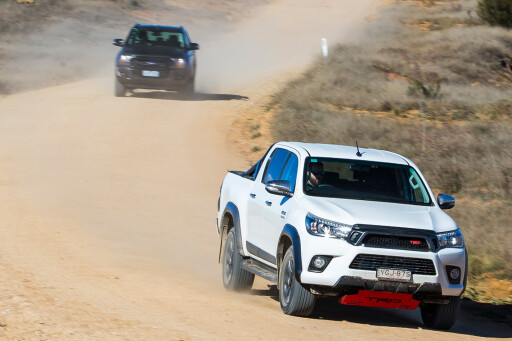 Opt for a manual and you’ll save $2000. It wasn’t hard to find much to like about the FX4 when comparing the two side-by-side. It had notably stronger and more relaxed performance, generally better road feel, bigger cabin, more towing and load-carrying capacity and ability, and off-road performance every bit as good as the Hilux.
Opt for a manual and you’ll save $2000. It wasn’t hard to find much to like about the FX4 when comparing the two side-by-side. It had notably stronger and more relaxed performance, generally better road feel, bigger cabin, more towing and load-carrying capacity and ability, and off-road performance every bit as good as the Hilux.
Mercedes-Benz G300 vs Toyota Land Cruiser 79 comparison review
As a ute to drive, it’s a better bet all round. The TRD counters with superior refinement, better fit and finish, a feel of quality the FX4 lacks, and a few important convenience features including ‘smart key’ entry and start, electric seat adjust, and tilt-and-reach wheel adjustment. Plus, it gets a tub liner and soft tonneau cover.
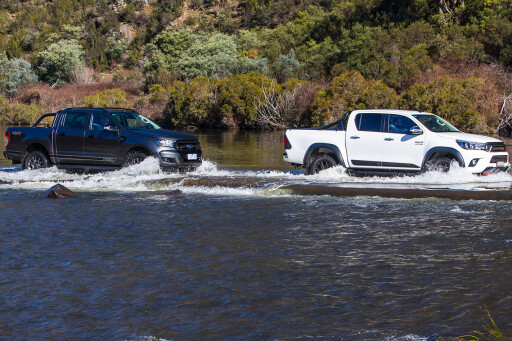 The TRD also comes with the promise of Toyota reliability and durability. On this point, there are a couple of pointed examples to consider: Why doesn’t the Hilux’s traction control stay active across the front axle when the rear locker is engaged? Because of durability concerns, according to Toyota engineers.
The TRD also comes with the promise of Toyota reliability and durability. On this point, there are a couple of pointed examples to consider: Why doesn’t the Hilux’s traction control stay active across the front axle when the rear locker is engaged? Because of durability concerns, according to Toyota engineers.
And why doesn’t the Hilux have electric power steering given the considerable benefits it brings? Because of durability concerns, according to Toyota engineers. So do you want a ute that’s better to drive, or potentially better to own in the long run?
Road tester Dan Everett summed it up succinctly by saying: “I’d buy the Ranger for myself, but as a fleet buyer I’d go for the Hilux.”

COMMENTS